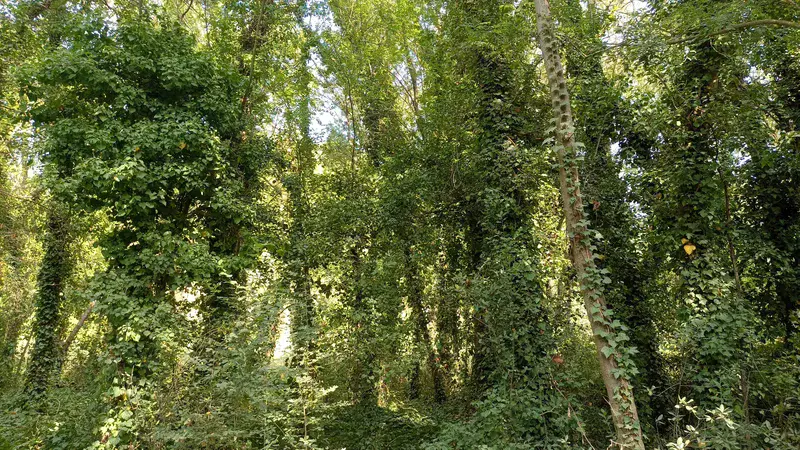
Riparian forest on Lake Banyoles: the living edge
by Antonio Jordán, University of Seville, Sevilla, Spain
First, in English:
Riparian forests in Spain are vital ecosystems that develop along rivers, streams, and other water bodies. These forests act as ecological corridors, providing habitat for diverse plant and animal species while also playing a crucial role in water quality, flood control, and erosion prevention.
Riparian forests in Spain consist mainly of tree species such as poplars (Populus spp.), alders (Alnus glutinosa), ashes (Fraxinus angustifolia), and willows (Salix spp.). The understory is often dense with shrubs like blackberry (Rubus ulmifolius) and honeysuckle (Lonicera spp.), along with a variety of herbaceous plants that thrive in moist soils.
Ecologically, these forests regulate the hydrological cycle by slowing down water flow, reducing sediment transport, and maintaining groundwater levels. They also serve as thermal buffers, moderating temperature fluctuations in adjacent aquatic habitats.
Riparian ecosystems support a remarkable diversity of organisms. Mammals such as otters (Lutra lutra) and wild boars (Sus scrofa) use these areas for food and shelter. Birds like the black stork (Ciconia nigra), the kingfisher (Alcedo atthis), and various warblers depend on these forests for nesting and foraging. Amphibians and reptiles, including the Iberian tree frog (Hyla molleri) and the ladder snake (Zamenis scalaris), thrive in these humid environments.
Additionally, these forests are home to a diverse range of insects, including pollinators like butterflies (Vanessa atalanta, Gonepteryx rhamni) and bees (Apis mellifera). The soil harbors rich microbial communities that play essential roles in nutrient cycling and organic matter decomposition, supporting the health of both terrestrial and aquatic systems.
Despite their ecological importance, riparian forests in Spain face several threats. Deforestation, urban expansion, and intensive agriculture lead to habitat fragmentation and water pollution. Invasive species, such as Ailanthus altissima (tree of heaven) and Arundo donax (giant reed), outcompete native vegetation, altering ecosystem dynamics. Climate change exacerbates these pressures, increasing the frequency of droughts and altering river flow regimes.
Conservation efforts focus on river restoration, reforestation with native species, and the establishment of protected areas. Maintaining the integrity of riparian forests is essential for preserving biodiversity, enhancing climate resilience, and ensuring the long-term sustainability of freshwater ecosystems.
Ahora, en español:
Los bosques ribereños en España son ecosistemas fundamentales que se desarrollan a lo largo de ríos, arroyos y otros cuerpos de agua. Actúan como corredores ecológicos, proporcionando hábitat para diversas especies de plantas y animales, además de desempeñar un papel crucial en la calidad del agua, el control de inundaciones y la prevención de la erosión.
Los bosques ribereños en España están formados principalmente por especies arbóreas como álamos (Populus spp.), alisos (Alnus glutinosa), fresnos (Fraxinus angustifolia) y sauces (Salix spp.). El sotobosque suele ser denso, con arbustos como zarzamoras (Rubus ulmifolius) y madreselvas (Lonicera spp.), junto con una variedad de plantas herbáceas adaptadas a los suelos húmedos.
Desde un punto de vista ecológico, estos bosques regulan el ciclo hidrológico al ralentizar el flujo del agua, reducir el transporte de sedimentos y mantener los niveles freáticos. Además, actúan como amortiguadores térmicos, moderando las fluctuaciones de temperatura en los hábitats acuáticos cercanos.
Los ecosistemas ribereños albergan una biodiversidad notable. Mamíferos como la nutria (Lutra lutra) y el jabalí (Sus scrofa) utilizan estas zonas para alimentarse y refugiarse. Aves como la cigüeña negra (Ciconia nigra), el martín pescador (Alcedo atthis) y diversas especies de currucas dependen de estos bosques para anidar y buscar alimento. Anfibios y reptiles, como la ranita de San Antón (Hyla molleri) y la culebra de escalera (Zamenis scalaris), prosperan en estos entornos húmedos.
Además, estos bosques son el hogar de una amplia variedad de insectos, incluidos polinizadores como mariposas (Vanessa atalanta, Gonepteryx rhamni) y abejas (Apis mellifera). El suelo alberga comunidades microbianas diversas que desempeñan funciones esenciales en el ciclo de nutrientes y la descomposición de materia orgánica, favoreciendo la salud de los ecosistemas terrestres y acuáticos.
A pesar de su importancia ecológica, los bosques ribereños en España enfrentan numerosas amenazas. La deforestación, la expansión urbana y la agricultura intensiva provocan la fragmentación del hábitat y la contaminación del agua. Las especies invasoras, como Ailanthus altissima (árbol del cielo) y Arundo donax (caña común), desplazan la vegetación autóctona y alteran la dinámica del ecosistema. El cambio climático agrava estas presiones, aumentando la frecuencia de sequías y modificando los regímenes de los ríos.
Los esfuerzos de conservación se centran en la restauración fluvial, la reforestación con especies autóctonas y la creación de áreas protegidas. Mantener la integridad de los bosques ribereños es esencial para preservar la biodiversidad, mejorar la resiliencia climática y garantizar la sostenibilidad a largo plazo de los ecosistemas de agua dulce.
Categories
Location
- Europe (3893)
- Southern Europe (1691)
- Spain (819)
- Exact location (2.7561 E, 42.1267 N)
Tags
Colours
Image properties
4000 × 2250 px;
image/jpeg; 4.0 MB
Camera:
Xiaomi M2103K19G
Taken on 4
August
2024
Submitted on 29 January 2025
Licence
Creative Commons Attribution-ShareAlike 3.0 Unported (CC BY-SA 3.0)
Credit
Antonio Jordán (distributed via imaggeo.egu.eu)
Share
Appreciate
Report